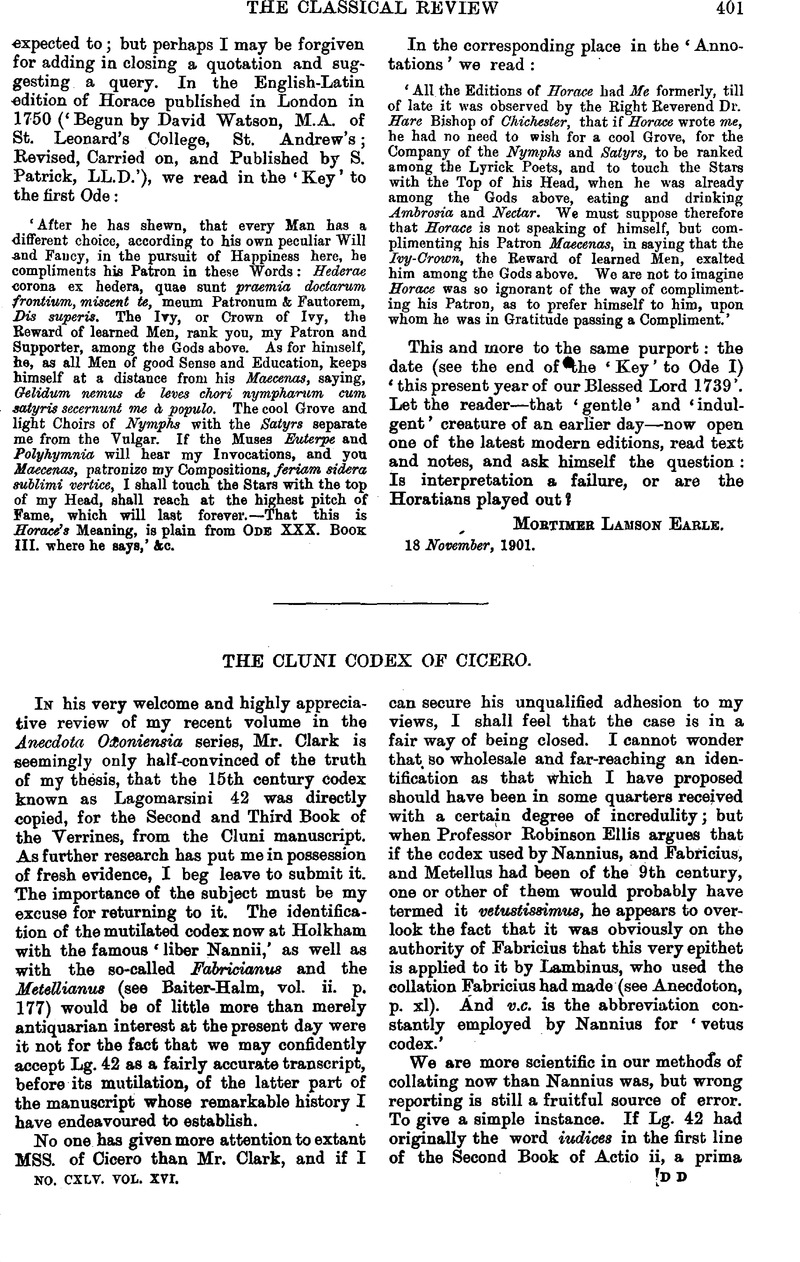No CrossRef data available.
Article contents
The Cluni Codex of Cicero
Published online by Cambridge University Press: 27 October 2009
Abstract

- Type
- Original Contributions
- Information
- Copyright
- Copyright © The Classical Association 1902
References
page 402 note 1 Some at least of the transposition variants whichmx appear in Lg. 42, as against all the other codd., will not be reproduced in my forthcoming edition of the Verrines. C. F. W. Müller seems to me to have accepted too many of them. The process out of which they must sometimes, at least, have resulted is revealed, e.g. at p. 343, 2, where all the MSS. have mihi videtur, except Lg. 42, which gives videtur mihi videtur. Here it would seem as if the writer of Lg. 42 had wanted to change the sequence, but carelessly repeated videtur. In the same way, at p. 283, 30, Lg. 42 gives et guaestuosissimumque, where -que is the writer's own, inserted either through inadvertence or by preference, or after comparison with the dett., while he forgot to delete the preceding et. Though Müller has been somewhat inconsistent in dealing with these variants, he has the credit of being the first editor of the Verrines who had a proper appreciation of the value of the tradition contained in Lg. 42, for the Second and Third Books. Here are some of the places where he seems to defer too greatly to its authority. At p. 282, 37, he prints Quid reliqui est with Lg. 42 against the codd. and edd. But here the Fabricianus is cited for Quid est reliqui, which must therefore have stood in Cluni, the inversion being probably due to caprice on the part of the writer of Lg. 42. Similarly at p. 282, 21, Lg. 42 has re vera quidem for re quidem vera: sociorum contra salutem, p. 357, 13, for contra sociorum salutem: and accepta pecunia, p. 228, 20, for pecunia accepta. It may well be doubted, therefore, whether the authority of Lg. 42 is sufficient for such a change in the text as rusticarum rerum, p. 279, 37, for rerum rusticarum (all other codd., including the Vaticanus): or sunt duae, p. 275, 22, for duae sunt: or sapientiam maiorum, ibid. 28, for maiorum sapientiam: or victu vitaque, p. 274, 35, for vita victuque: or quam sibi, p. 281, 15, for sibi quam: or decumanum putatis, ibid. 3, for putatis decumanum. All these, however, Müller adopts, though on the same principle he ought to have accepted the inversion in Lg. 42, praesertim magno, p. 296, 28, for the vulgate magno praesertim, and ut ex maxima parte, p. 288, 8, for ex maxima parte ut. The Cluni codex, where it is still extant, may be brought as a witness against the copyist of Lg. 42 in at least two places, which may be cited to complete this note. At p. 209, 5, it gives nostros comites, with most codd., whereas the first hand in Lg. 42 hag comites nostros (wrongly adopted by Müller): here Lg. 42 first capriciously changes the order in C, and then either the writer himself, or the second hand, finding that the dett. were against him, restores the right order. Again, at p. 240, 24, C gives dies festi aguntur: this appears in Lg. 42 as festi dies aguntur, subsequently corrected. That the first hand himself made corrections in what he had written, on a comparison, probably, with some member of the dett., is obvious from such examples as p. 204, 33, where the original order, copied from C, negotiantur in Sicilia, is altered by the m. p. to in Sicilia negotiantur.
Two places may be noted on which a suggestion might be based that the writer of Lg. 42 did part, at least, of his work to dictation: p. 241, 22, where he gives venisset redditus for venisset hereditas, and ibid. 25, propetissetfor poposcisset.
page 403 note 1 In the last-named passage the fact that Müller now reports that the lacuna following Nam cum a multis includes the autem after the second multis might lead one to suspect that the autem formed no part of the Cluni text. Other omissions, per incuriam, in Lg. 42, should not be considered of any account except where the support of F M or φ shows that they were omissions also in C. Thus I regard the absence in Lg. 42 of et fortissimo at p. 308, 16, as accidental: and the same holds of omnium (bracketed by Kayser and Müller) at p. 274, 33.
page 403 note 2 Nannius carelessly left the first words of his lemma stand uncorrected, and pays the penalty in Jordan's note ‘non nescit N.’
page 403 note 2 Reifferscheid's collation of Lg. 42, which was placed at C. W. Müller's disposal, has not been published in full, but it enabled Müller to correct many points in the previous reports of Jordan and Halm.


